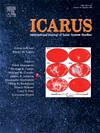观测几何和加热对水星模拟物紫外至近红外光谱的影响
IF 2.5
2区 物理与天体物理
Q2 ASTRONOMY & ASTROPHYSICS
引用次数: 0
摘要
由于行星的自旋/轨道共振,水星的温度在不同纬度上变化很大,导致表面光谱特性的改变。即将到来的BepiColombo任务将在UV-TIR范围内绘制行星表面图,提供对表面变化的更全面的了解。然而,由于观测几何结构的巨大差异,比较BepiColombo和过去信使号任务之间的光谱测量可能具有挑战性。为了了解空间环境的影响和解释轨道光谱测量结果,有必要在与天基观测相似的观测条件下进行近距离地面类似物的实验室实验。本研究展示了水星模拟物的紫外-近红外光谱,以了解观测几何形状和温度对行星表面光谱特性的影响。模拟物(由钠长石、钠长石和合成硫化物组成的混合物)及其末端成员在六个几何形状下进行了测量,这些几何形状为两个任务的观测条件提供了样本。样品在新鲜和加热到450°C后经过三个循环测量。研究发现,观测几何形状对样品反射光谱的影响随波长和成分的不同而不同。随着相位角的增加,模拟物在紫外-近红外域呈现变暗、变红和变平。加热后的样品呈现增亮和变红,吸收带加深。随着Mg丰度的增加,与观测几何形状和加热有关的光谱变化更强。本文章由计算机程序翻译,如有差异,请以英文原文为准。
Effects of observation geometry and heating on the ultra-violet to near-infrared spectra of Mercury simulant
The temperature of Mercury varies greatly across different latitudes due to the planet’s spin/orbit resonance, leading to modifications in the surface spectral properties. The upcoming BepiColombo mission will map the surface of the planet in the UV-TIR range, providing a more comprehensive understanding of the surface alteration. However, comparing the spectral measurements between BepiColombo and the past MESSENGER mission could be challenging due to the large differences in observation geometry. Laboratory experiments with close surface analogs in viewing conditions similar to the space-based observations are necessary to understand the effect of the space environment and interpret the orbital spectral measurements. This study presents the UV-NIR spectroscopy of a Mercury simulant to understand the impact of observation geometry and temperature on the spectral properties of the planet’s surface. The simulant (a mixture of aubrites, albite, and synthetic sulfides) and its endmembers are measured under six geometries that sample the viewing conditions of both missions. The samples are measured fresh and after heating to 450 °C during three cycles. This study finds that the observation geometry modifies the reflectance spectrum of the samples differently depending on the wavelength and composition. The analog presents a darkening, reddening, and flattening with increasing phase angle in the UV-NIR domain. The heated samples present a brightening and reddening, with a deepening of absorption bands. The spectral changes associated with observation geometry and heating are stronger with increasing Mg abundance.
求助全文
通过发布文献求助,成功后即可免费获取论文全文。
去求助
来源期刊

Icarus
地学天文-天文与天体物理
CiteScore
6.30
自引率
18.80%
发文量
356
审稿时长
2-4 weeks
期刊介绍:
Icarus is devoted to the publication of original contributions in the field of Solar System studies. Manuscripts reporting the results of new research - observational, experimental, or theoretical - concerning the astronomy, geology, meteorology, physics, chemistry, biology, and other scientific aspects of our Solar System or extrasolar systems are welcome. The journal generally does not publish papers devoted exclusively to the Sun, the Earth, celestial mechanics, meteoritics, or astrophysics. Icarus does not publish papers that provide "improved" versions of Bode''s law, or other numerical relations, without a sound physical basis. Icarus does not publish meeting announcements or general notices. Reviews, historical papers, and manuscripts describing spacecraft instrumentation may be considered, but only with prior approval of the editor. An entire issue of the journal is occasionally devoted to a single subject, usually arising from a conference on the same topic. The language of publication is English. American or British usage is accepted, but not a mixture of these.
 求助内容:
求助内容: 应助结果提醒方式:
应助结果提醒方式:


